Garden Center
Pictures of our Garden Center:
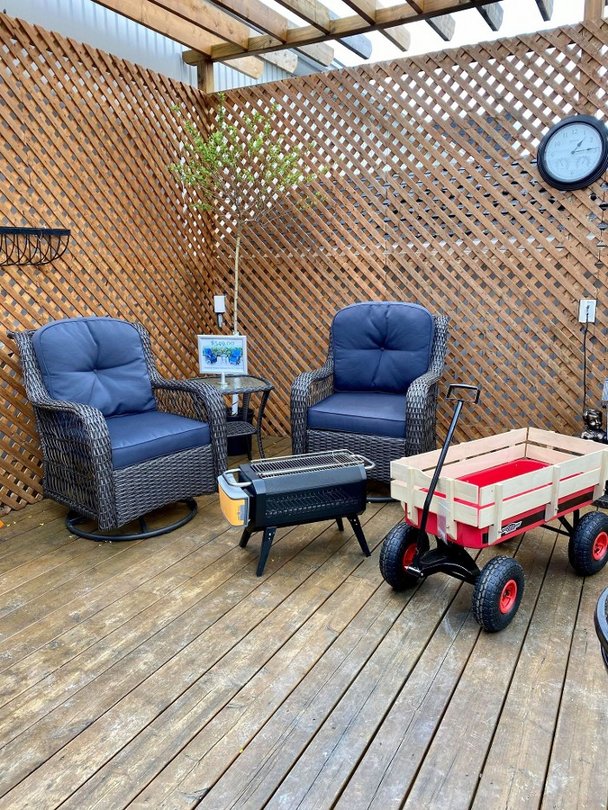
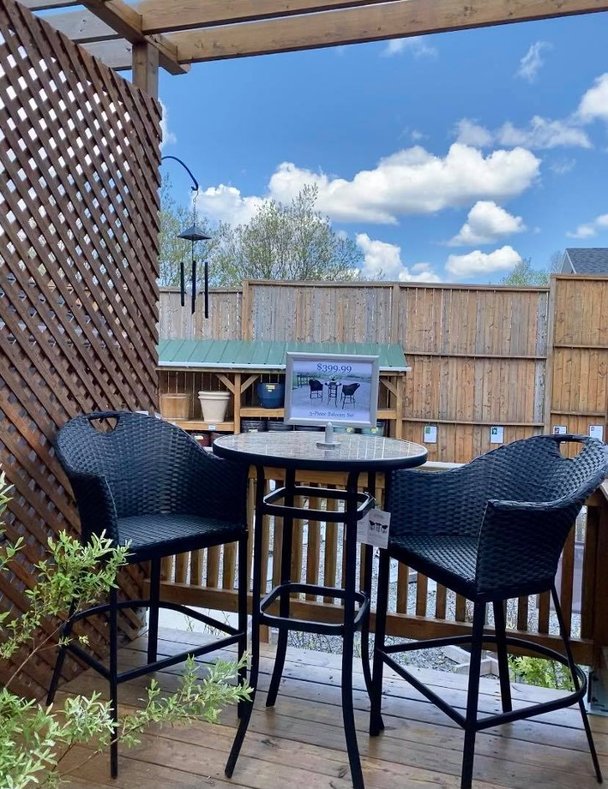
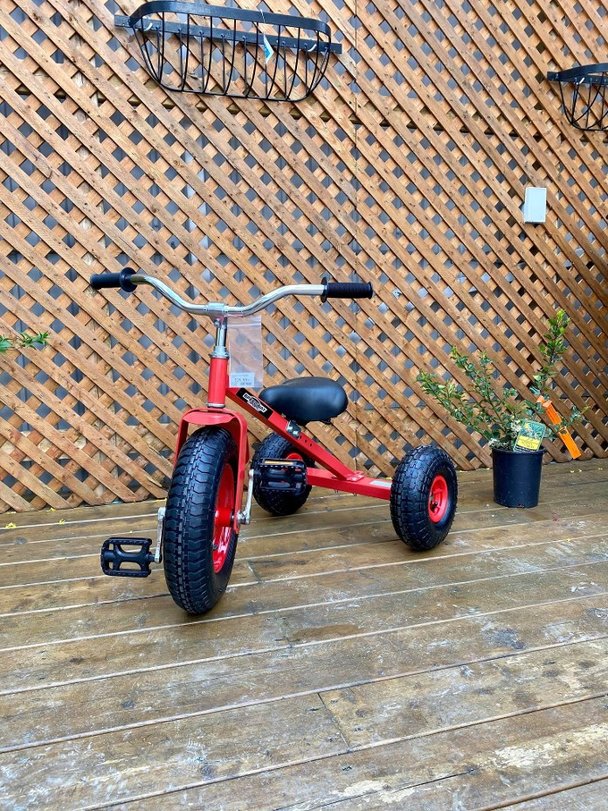
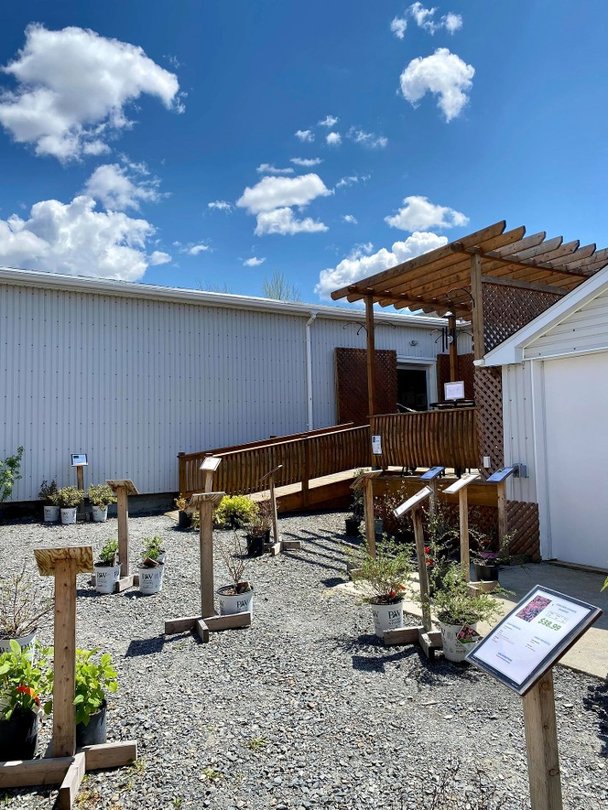
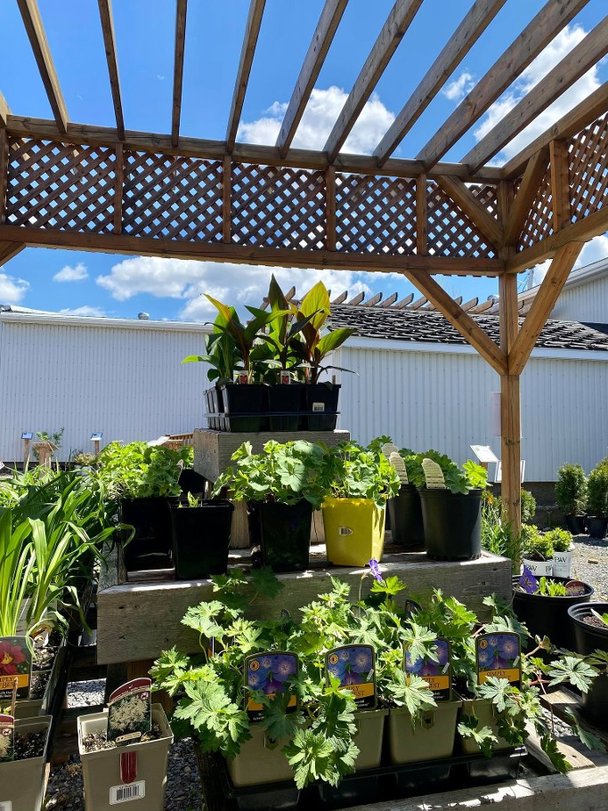
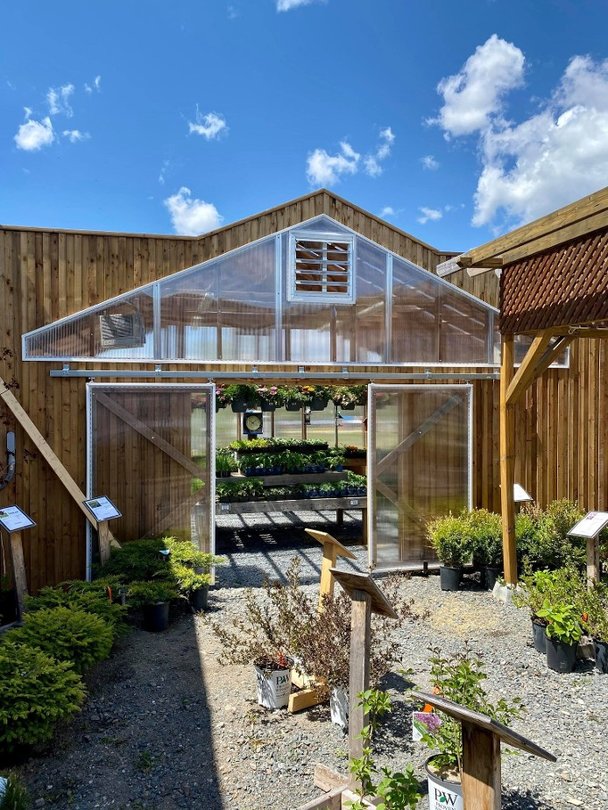
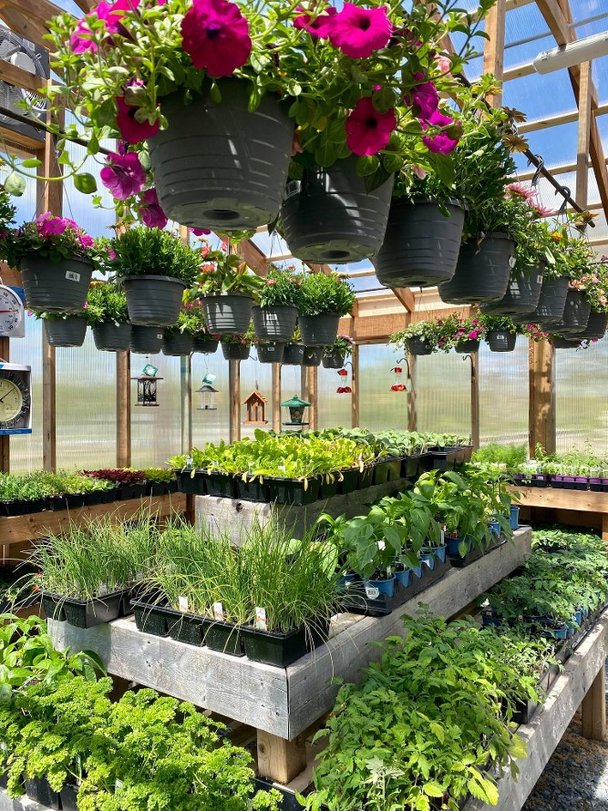
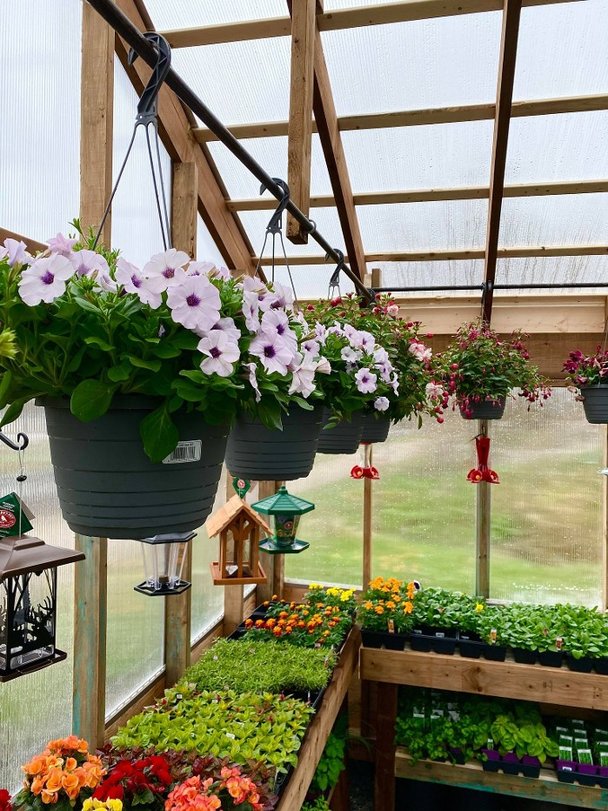
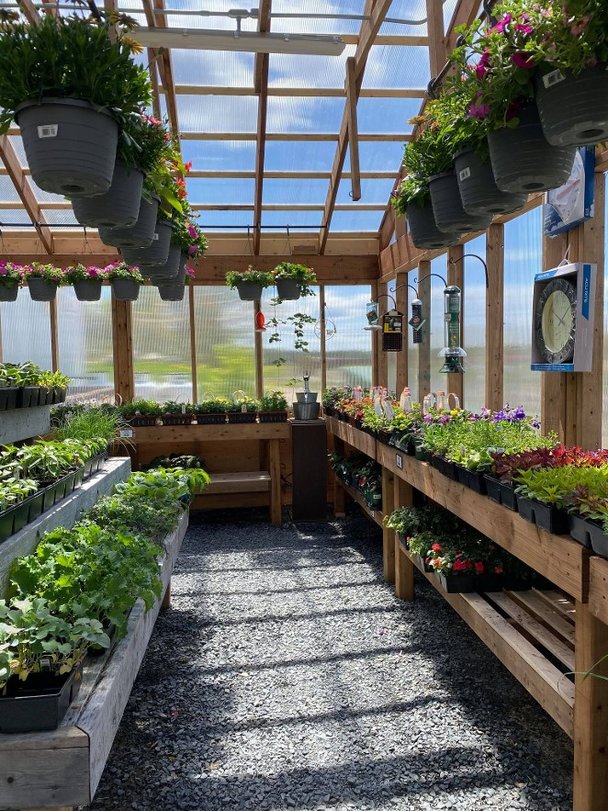
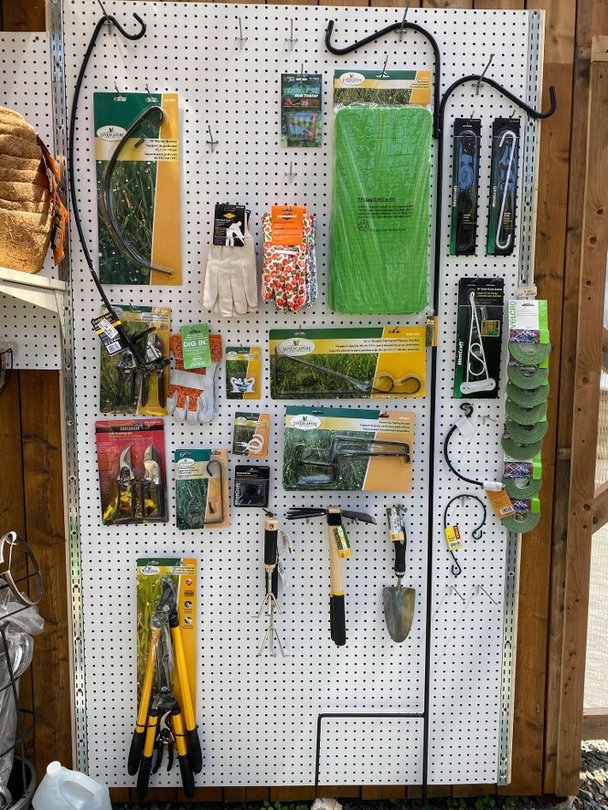
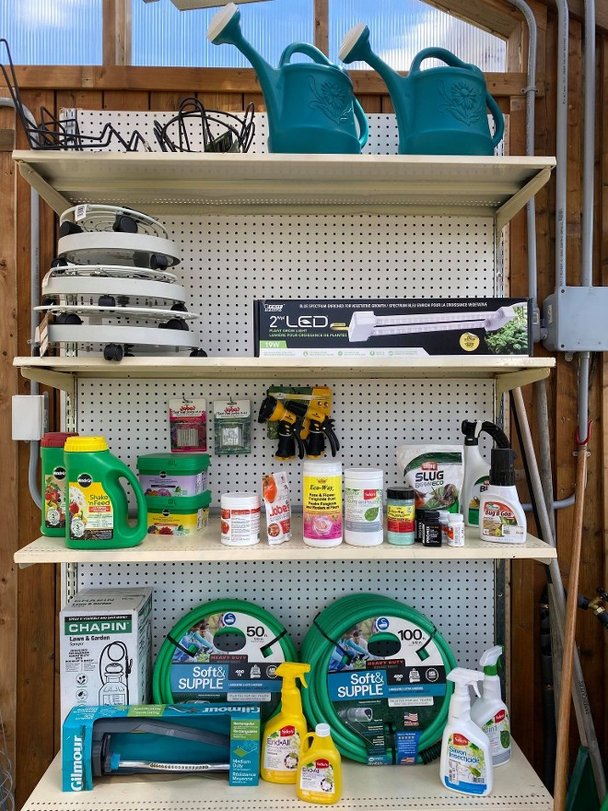
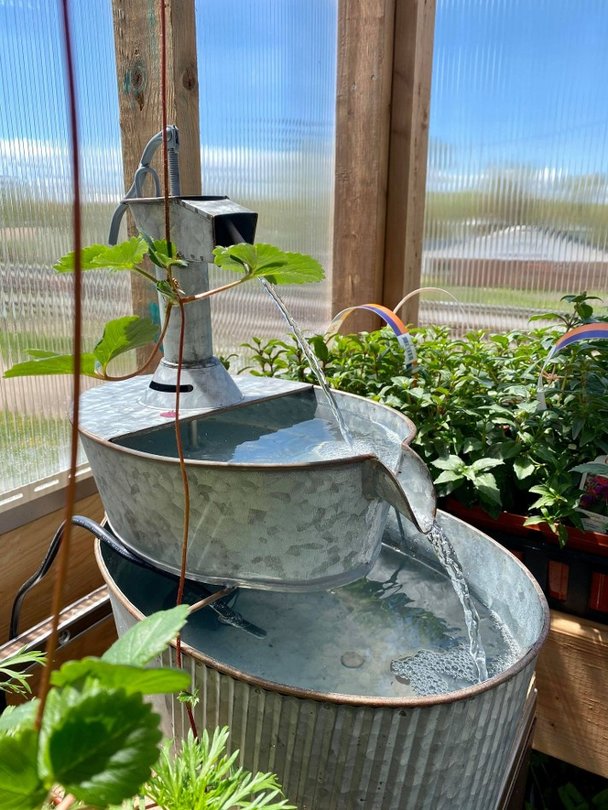
On The Side Of Our Warehouse You'll Notice A "Soil Menu" Where You Can Find The Prices And Description Of Our Composts, Potting Soils, And Mulch.
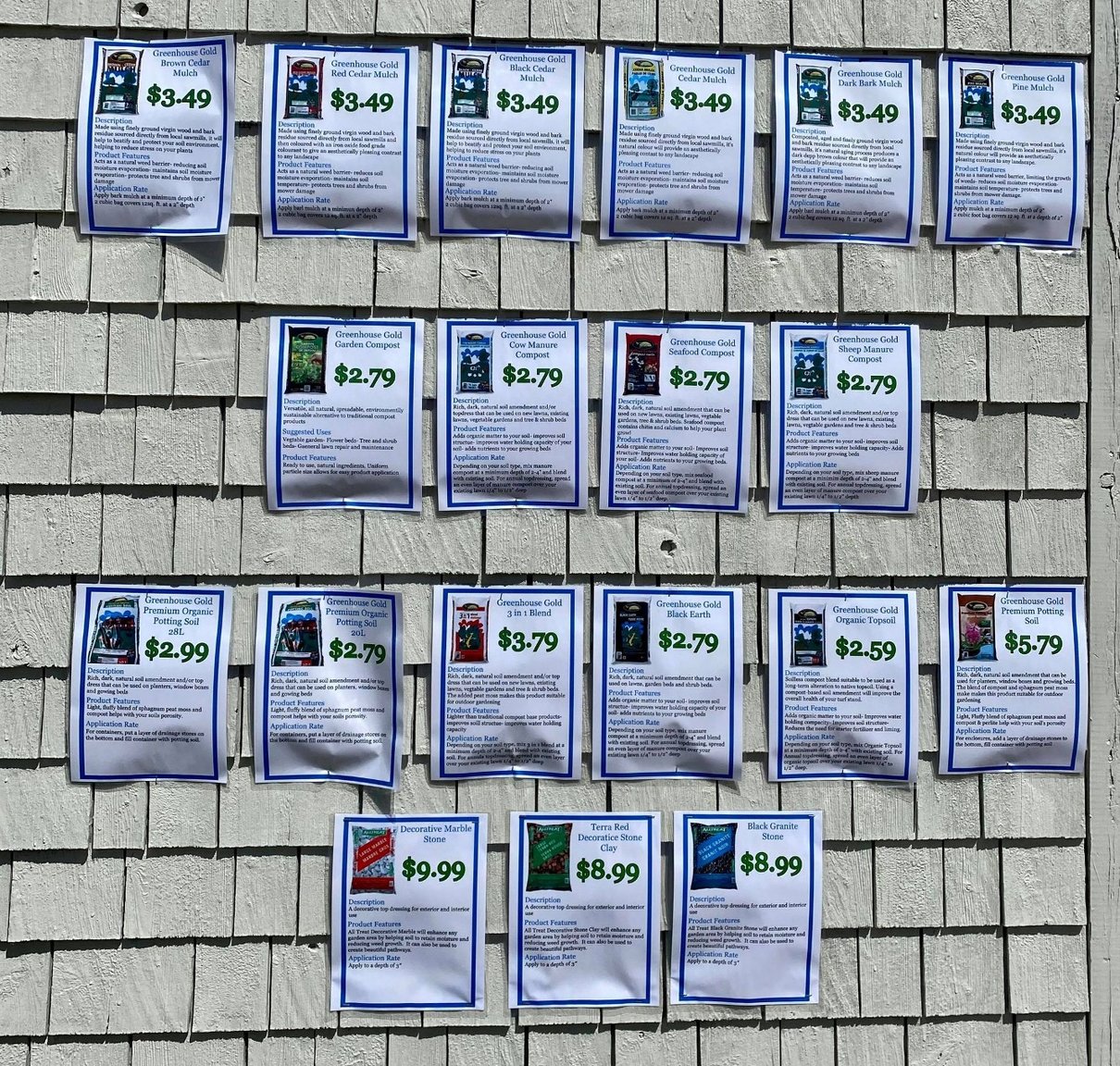
TLC FOR HEALTHY LAWNS
For the Atlantic region
MOWING
-Raise the mower height — 6.5–7.5cm (2.5 to 3")
-1/3 rule — cut not more than 1/3 of the grass blade in any one mowing
-Keep the blade sharp — sharpen 1–2 x per season; be safe: (disconnect
sparkplug, use
gloves)!!!
Rationale: These simple mowing steps will create stronger grass with deeper roots. This means less watering, better insect resistance, and improved weed suppression. It is also easier on your mower, will produce less grass clippings (that can be left on the lawn) and save fuel.
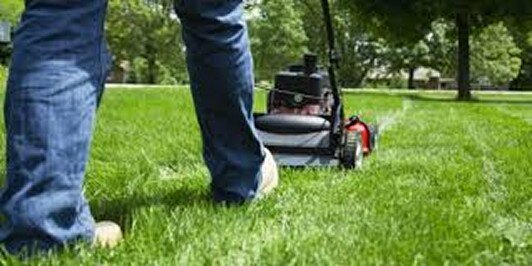
LEAVE THE CLIPPINGS
-Do not remove grass clippings from the lawn
Rationale: Lawn clippings are Nature’s perfectly balanced, slow release, non-polluting lawn fertilizer.
Leaving them on the lawn conserves fuel, labor, landfill capacity, and improves the soil structure and health. They can reduce purchased fertilizer needs by up to 50%.
LIMING
-Soil pH of 6.5 is ideal
-Have soil tested (every 3 years once pH is known)
-Apply lime anytime during growing season
-Maintenance (0.5 kg lime required for each 0.5 kg fertilizer applied)
Rationale: Lime conditions the soil and will improve turf growth, health and vigor. Grass plants grow better in a more neutral soil pH because of improved soil microbial activity (Nature’s food processing factory) and fertilizer efficiency (better uptake by plants). At the correct pH there is less potential loss of added nutrients and thatch is reduced. Lime is a completely natural product (crushed limestone). Pellet forms are more easily applied and faster acting. Nitrogen fertilizers decrease soil pH and create the need for additional lime. Once the soil pH is adjusted to 6.5, it can be maintained by adding 1 pound (0.5 kg) of lime for every 1 pound (0.5 kg) of fertilizer applied.
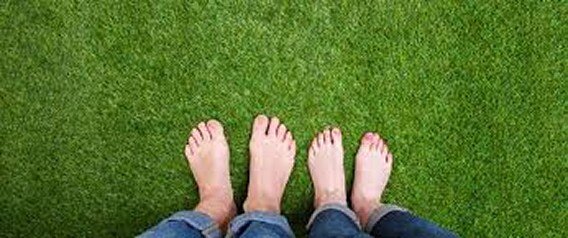
FEEDING AND FERTILIZERS
-Feed only when the grass is actively growing
-Ideal application timing is, first, September and second, mid-June
-Use controlled-release, organic based or true organic fertilizers
-Nitrogen applied at 0.5kg/100 sq. meters (1.0 lb/1000 sq. ft) per season is adequate
Rationale: Easy does it! Nitrogen, the first number on the fertilizer bag is the growth throttle for turf (the more you feed, the faster the grass grows!). Every lawn needs some Nitrogen added annually. Often just 1 pound (.5 kg) per 1000 sq. ft (100 sq m) is enough per season for a healthy lawn that is growing on a good soil base. Turf on a poor soil base (less than 18” — 45cm) will require more fertilizer — up to 3 lb (1.5 kg) per 1000 sq. ft (100 sq. meters).
What about the other 2 fertilizer components, phosphate (P) and potash (K), the 2nd and 3rd numbers on the fertilizer bag? They stay in the soil and are recycled unless removed with clippings. Medium levels (as determined by soil tests) have proven effective for healthy lawn growth. As such most lawn fertilizers have only low levels of P and K in the formulation. A ratio of 4-1-1 is ideal.
Caution should be used to apply fertilizer only on the grass. Fertilizer splashed onto streets, sidewalks and driveways is wasteful and can contaminate streams and rivers.
Controlled-release, organic based and true organic fertilizers are better for balanced and sustainable turf growth. They are also more environmentally friendly with less risk of volatilization (escaping into the air) and leaching into the groundwater.
Small white clover plants evenly dispersed in a lawn provide enough nitrogen to feed a lawn naturally, if the clippings are recycled. As a specialized legume type plant, clover has the ability to capture nitrogen from the air, manufacture it and release it into the soil.
Mid-September is the ideal time for feeding the lawn. At this time, most of the applied nutrients are utilized for building healthy roots, crowns and overall stronger plants. Stored nutrients and energy will then be utilized more efficiently in the spring and provide quicker green-up without excessive top-growth. Mid-June, after the spring growth flush tapers off, is the second most effective feeding window.
Early spring, mid-summer and late fall feeding can actually waste nitrogen — allowing it to leach beyond the roots or evaporate (volatilize) into the air. Early spring feeding also increases mowing frequency, creates excessive clippings, wastes energy, and can actually weaken the turf. From an environmental perspective, application timing is less critical with completely organic
products, because the nitrogen component is released only when the grass is growing – so the grass captures it all.
WATERING
-Not necessary on healthy, sustainable lawns
-1.5–2.5 cm(½ – 1 inch) per week
-Keep it on the grass, not streets or sidewalks!
Rationale: Properly constructed lawns (with a deep, unrestricted soil base) stay green without additional watering. Lawns that turn brown in mid-summer are OK. They will recover in the fall unless added stress occurs (summer fertilizing, low mowing).
The most environmentally sensitive approach is to not water the lawn. The moderately conservation minded will water enough to keep a green appearance (1.25cm or 1/2” per week, in one application so it soaks in deeply) if natural rainfall does not occur. This can be easily measured by using an empty sardine can and placing it half way out in the sprinkler pattern. Applying 2.5cm or
1” of water per week (use a tuna can) will keep a lawn growing vigorously in our climate. If Nature provides natural rainfall, reduce the applied water accordingly. Application in early morning will reduce loss of water from evaporation. And try to keep the water on the grass – not on the street, sidewalks or driveways. It is a valuable resource – use it efficiently!
AERATION
If required:
-Once per year
-Full depth tine penetration gives best results
Rationale: Aeration is not normally required in healthy lawns. It can help relieve problems, such as helping to break down a heavy thatch layer by bringing some soil to the surface. It can also help to improve the results of overseeding and topdressing by getting seed and organic matter into the root zone.
Compaction is not a problem in home lawns in most of Atlantic Canada due to our winters. Nature’s freeze-thaw cycle does an excellent job at relieving compaction — if we stay off the lawn until it dries out (the sour smell and squishy feel is gone). This is the reason we get big bumps in the road and have highway weight restrictions! Earthworms and soil microbes also assist with keeping the soil opened up.
MANAGING THATCH
Correct the soil pH to 6.5
Reduce fertilizer applications (0.5–1.0 kg Nitrogen per 100 sq.
meters, 1–2 lbs per 1000 sq ft) per season
Topdress with good compost
Reduce pesticide applications
Rationale: Thatch occurs from the breakdown of coarse grass plant parts (stems), and is a natural part of the nutrient cycle. (The dark layer on top of the soil in the picture at the right is thatch.) Leaf clippings break down rapidly, and do not normally add to thatch. Too much thatch — over ¾” (1.75cm) — is a caused by poor management or construction practices that suppress the soil life and natural breakdown of thatch.
Contributing factors are low pH, high rates of fertilizer, frequent insecticide applications, poor drainage and compaction. If the first three are the problem, correcting them has been shown to solve the problem over two or three years. Topdressing with good, biologically active compost also helps. The valuable nutrients and organic matter in the thatch are broken down by the compost and returned to the soil. Thatch removal is seldom required in effective home lawn management programs.
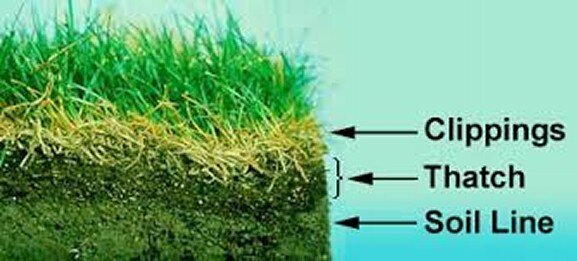
MANAGING WEEDS
-Some weeds are OK
-Hand weeding is effective (and good exercise!)
-Healthy turf can reduce weeds
Rationale: A weed-free lawn is an artificial concept in nature, and requires significant energy to maintain. Research has shown that most people consider a lawn to be weed-free when it actually contains up to 10% of finer-leaved broadleaved plants (clover, chickweed). Even 50% broadleaf content (biodiversity) is attractive if kept neat by regular mowing.

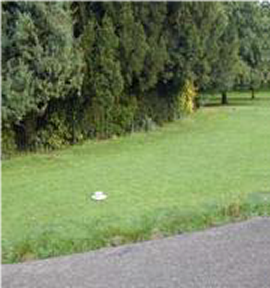
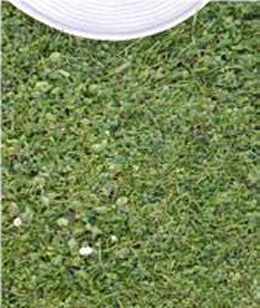
These photos, taken at Windsor Castle, show the attractive uniform colour typical of European turf. The lighter green is the result of minimal fertilization. The right photo shows the biodiversity present at the location of the hat in the center photo — 30% or more broadleaf content, mostly white clover. A biodiverse turf requires less watering to stay green in summer, takes less fertilizer, and tolerates higher chinch bug populations without visible damage.
If turf health is improved (correct pH, correct mowing) the grass plants become denser and more aggressive. They are able to crowd out unacceptable weeds and prevent new ones from germinating. Occasional spot herbicide applications will keep a lawn practically weed-free. In this photo, the healthy turf on the left remains nearly weed-free three years after installation — the thick grass helps keep the weed seeds from germinating.
If herbicides are used for undesirable weeds, application timing is important. They work best when the turf — and weeds — are actively growing in the spring and fall. Apply to plants before they flower and set seed (especially dandelions — spraying after the flowers appear guarantees a repeat crop!). Hand weeding with simple tools has been shown to be as cost effective as herbicides for removing large weeds like dandelions if they are less than 10% cover in the lawn.
MANAGING INSECTS
-Bio-diverse lawns resist insects better
-Reduce the amount of fertilizer used
-Water dry areas — June and July
-Chinch bugs — spot-treat with insecticide, if required, from mid-July to mid-August
Rationale: Most insects are beneficial in a balanced, healthy ecosystem. They help to recycle organic matter, return it to the soil, and in turn, feed the plants. Chinch bugs, the most prevalent lawn pest in Atlantic Canada, are unfortunately not very helpful and sometimes cause significant injury. A healthy, bio-diverse lawn however can tolerate a lot of chinch bugs (counts up to 1200 per
sq ft or 0.1 sq m have been recorded without visible damage!). This is well above the number historically considered to be damaging to turf. Older lawns, established prior to 1940 (pre- WW2) have been observed to be less affected by chinch feeding. This is thought to be due to more available moisture from a deeper and undisturbed root zone which keeps grass from getting stressed.
Chinch bugs are known to congregate in “hot spots” — dry, sunny areas and sunny slopes. Keeping these sensitive areas moist from mid-June to mid-July will suppress insect feeding damage, by improving turf health and encouraging natural fungal pathogens.
Over-fertilized lawns are more attractive to Chinch bugs and more vulnerable to damage. If insecticide control is required, the best time to apply is when the chinch bug is in the immature stage (immature nymphs are orange-red in color) before they turn into adults. In the Atlantic region, this stage occurs from mid July to mid August.
TOPDRESSING AND OVERSEEDING
-Compost will help reduce thatch
-Seed will help to fill bare and thin areas Seed
-must contact soil to get established Mechanical
seeders and aeration can be helpful
Rationale: Topdressing refers to the application of a layer of compost and/or soil to an existing lawn; overseeding means spreading seed onto an existing lawn. These practices can help to increase grass cover in thin areas and introduce new plant varieties to a lawn.
Topdressing with a good compost is beneficial. Composts must be uniform, dry or in a pellet form to apply effectively with conventional mechanical spreaders. If not, hand application and raking-in is required. Composts and topdressing may be applied any time during the season.
Overseeding must place the seed in contact with the underlying soil to allow germination and rooting. Consistent moisture is essential for 6–8 weeks until the grass is established. Early spring or early fall timing is recommended to take advantage of natural rainfall. Commercial equipment such as a slitting seeder helps to correctly place the seed in contact with the soil. A mechanical aerator can also help improve seed-to-soil contact. Hand tools like a garden fork are effective for small areas.
Seeds must have good soil contact and consistent moisture in order to survive and grow.
The common permanent grass species used in the Atlantic region for lawns are Kentucky Bluegrass and Creeping Red Fescue. Perennial ryegrass is generally not hardy will die out after a few years. It does germinate quickly however and is used as a “nurse” grass for the permanent species and for a quick cover.
In good growing conditions, established grasses will spread rapidly (with side shoots and stolons) to fill in small bare spots and often eliminate any need for overseeding. In poorer soils, overseeding provides only a temporary repair.
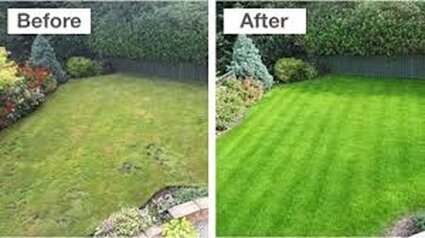
COMPANION PLANTING
Each garden is unique. There are factors that should go into consideration while planning your garden, including sun exposure, weather, pollinators, insect population, soil quality, water supply and harvest planning. Plants can help each other by improving soil nutrients, attracting natural predators, and repelling insects.
Before the use of chemical fertilizers and pesticides, it was known that certain plants grow and/or taste better when planted next to each other. Companion planting is a safe, natural way to garden.
Minimizing Risk: If one crop fails or is affected by harsh weather, pests or disease then the overall yield of your plot may be increased by limiting the spread. Focus creating the best natural growth patterns and diversity in your space.
Crop Protection: Companion planting can offer a more delicate plant shelter from weather, by creating a natural defence against the harsh conditions.
Trap Cropping: Companion planting is the ultimate organic pest management. You may keep away unwanted pests that may be attracted to one crop but repelled by another.
Positive hosting: By planting in proximity to plants which produce a surplus of nectar and pollen, you can increase the population of beneficial insects that will manage a harmful pest population.
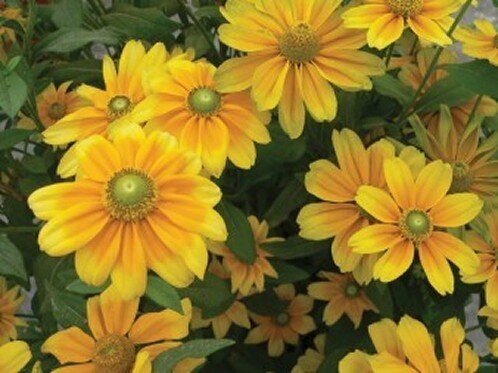
HERBS THAT KEEP INSECTS AWAY
·Peppermint – repels ants, white cabbage moth, aphids, and flea beetle. Since Mint is a notorious spreader that can easily get out of control establish it in pots that are above ground or sunk below where roots can’t escape drainage holes.
·Garlic – discourages aphids, fleas, Japanese beetles, and spider mites.
·Perennial Chives – repel aphids and spider mites, two very common garden pests. Chives are often planted among roses to keep aphids away and to resist the Black Spot disease.
·Basil – drives away flies and mosquitoes.
·Borage – deters that monster of vegetable garden insects, the tomato hornworm.
·Rosemary and Sage – repel cabbage moth, bean beetles, and carrot flies.
·Annual Marigolds – can be used anywhere to deter Mexican bean beetle, squash bug, thrips, tomato hornworm, and whitefly. They are also known to repel harmful root knot nematodes (soil dwelling microscopic white worms) that attack tomatoes, potatoes, roses, and strawberries.The root of the Marigold produces a chemical that kills nematodes as they enter the soil. If a whole area is infested, at the end of the season, turn the Marigolds under so the roots will decay in the soil. You can safely plant there again the following spring.
·Nasturtium – is another annual, in this case a trailing vine that keeps away Colorado potato bug, squash bug, and whitefly.
·Artemisia or Wormwood (perennial) – deters slugs that are so devastating to foliage.
Radish – can be planted to discourage cucumber beetle, squash bug, and stink bug.
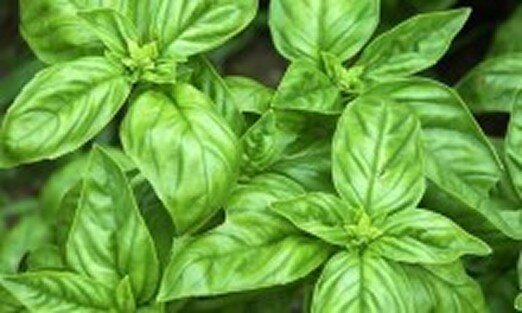
IDEAL PLANTING COMPANIONS FOR VEGETABLES
The following is a list of vegetables and their ideal planting companions, plus combinations to avoid.
·Beans like celery and cucumbers but dislike onions and fennel.
·Beets are compatible with bush beans, lettuce, onions, kohlrabi, and most members of the cabbage family.
Keep pole beans and mustard away from them.
·Cabbage, celery, dill, onions, and potatoes are good companion plants.
Dislikes include strawberries, tomatoes, and pole beans.
·Carrots, lettuce, radish, onions, and tomatoes are friends.
Dill isn’t, so plant it at the other end of the garden.
·Corn prefers to be near pumpkins, peas, beans, cucumbers, and potatoes.
Keep tomatoes away.
·Cucumbers like sweet corn, peas, radishes, beans, and sunflowers.
Dislikes include aromatic herbs and potatoes.
·Lettuce grows especially well with onions.
They are also compatible with strawberries, carrots, radishes, and cucumbers.
·Onions can be planted near lettuce, beetroot, strawberries, and tomatoes, but keep well away from peas and beans.
·Peas, carrots, cucumbers, sweet corn, turnips, radishes, beans, potatoes, and aromatic herbs are good companions.
Keep peas away from onions, garlic, leek, and shallots.
· Radish grows well with beetroot, carrots, spinach, parsnip, cucumbers, and beans.
Avoid planting near cabbage, cauliflower, brussel sprouts, broccoli, or turnips.
·Squash can be planted with cucumbers and corn.
·Tomatoes, carrots, onions, and parsley are good companion plants.
Basil improves growth and flavour.
·Plant vegetables, herbs, and flowers in your garden to attract predatory insects that will feed on the harmful, undesirable insects.
·Perennial Yarrow attracts ladybugs that consume masses of aphids.
·The Lacewing feeds on aphids, mealybugs, mites, and scale but needs lots of pollen from flowers and evergreens for shelter.
·Wasps and bees are also beneficial to the garden.
·The praying mantis is a friend, so don’t discourage it from visiting.
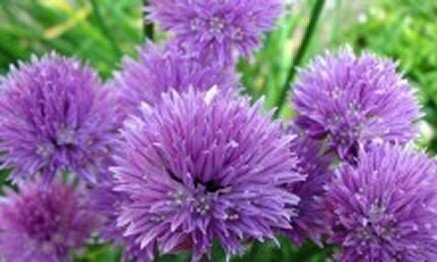
ATTRACTING BIRDS TO YOUR GARDEN
Birds feed on seed, berries, fruit, nuts, and insects. Some of these things can be provided by plant material in your own garden.
Feeding stations left out in the open most likely will not attract birds as this draws attention from hawks and cats. Birds need to be able to escape quickly to nearby trees, evergreens and shrubs to hide.
The dense foliage of Spruce, Pine, Fir, and Hemlock also provides ideal nesting sites as well as winter shelter.
GARDEN PLANTS THAT ATTRACT BIRDS
·Trees - Mountain Ash, Shubert Chokecherry, Birch, Crab Apple, and Hawthorn
·Smaller Shrubs - Serviceberry, Highbush Cranberry, Quince, female Winterberry, Pagoda and Gray Dogwood, Russian Olive, Honeysuckle, Elder, and Sumac.
·Vines - Boston Ivy, Virginia Creeper, Wild Grape, and American Bittersweet
·Annuals - Sunflowers, Cosmos, Zinnias, Marigolds, and Celosia
·Perennials - Globe Thistle, Black-eyed Susan, Asters, and Ornamental Grasses in the winter garden are valuable seed sources during a long, cold winter.
·Berries from - Fairview, Iowa, and Spartan Juniper, female Holly, Oregon Grape, and Wintergreen.
·Some birds love Sweet Cherries and Blueberries so be prepared to cover your fruit with black netting if you hope to harvest any for yourself.
BIRD SEED
·Feed the birds year-round, not just in winter, so you can enjoy the beauty of summer visitors too.
Don’t worry about the birdseed that falls on the ground; Mourning Doves and Juncos love to clean up the left overs.
·Sunflower Seed - These types will attract all birds while the black is a particular favourite of Blue Jays, Cardinals, and Chickadees.
·Wild Finch mixture and Niger Seed - sold in smaller quantities to specifically attract Finches.
Suet Cakes - an important food source for many birds in winter including Chickadees, Woodpeckers, and Nuthatches.
You can purchase a suet cage that fits a suet cake perfectly if you don’t already have one built onto your feeder.
BIRD FEEDERS
Besides having plants that naturally produce food for the birds, you can also provide a constant supply of seed and nuts in bird feeders. There are many styles and sizes of bird feeders to choose from:
·Wood Feeders
·Plastic Feeders
·Hanging Feeders
·Pole Mounted Feeders
·Squirrel Proof Feeders
·Suet Feeders
Bigger birds like Blue Jays and Cardinals won’t land on a small feeder.
Tubular feeders have small perches with small or large seed openings.
There is a tubular feeder called an 'Upside Down Feeder' that is for Goldfinches only.
These are the only birds that will land on a perch and flip upside down to feed on the small opening directly below.
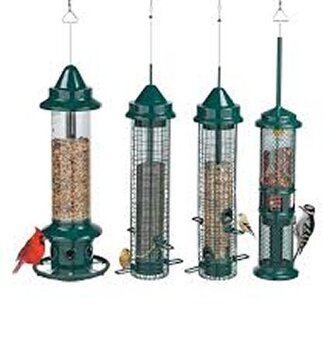
Winter Feeding
·Feeding the birds in winter is important for multipule reasons:
·During winter, natural food sources are depleted and difficult to find.
·Birds are buring more calories trying to keep warm.
·Extra fat and calories will better prepare the birds for the upcoming mating season.
Eggs will be laid sooner and chicks will be a healthier and heavier weight.
WATER
·Birds need water to survive as much as they need food source.
·If you aren’t near a natural body of water, you can provide it in a birdbath, fountain, or small water garden in partial shade.
Not only will birds drink the water but they will bathe in it to cool off.
·Change the water frequently so harmful bacteria does not build up.
Put out fresh water each day or invest in a birdbath heater for the winter to prevent the water from freezing in the winter.
BIRD HOUSES
·Birdhouses vary in size especially in the diameter of the hole so other birds can’t get in to raid a nest of eggs.
·Place a birdhouse in the shelter of a tree, away from predators, facing away from prevailing winds and precipitation.
·Purple Martins, the largest member of the Swallow family, like to live together in groups. Martin houses are available and are designed for their special needs.
They are mounted on a pole and require thorough cleaning each year before a new colony will take up residence.
Purple Martins are highly prized because their primary food source is mosquitoes.
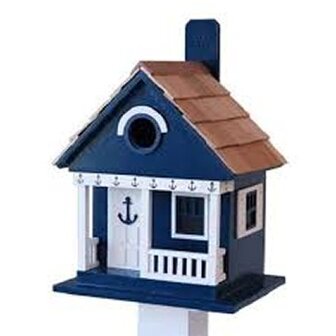
ATTRACTING HUMMINGBIRDS & BUTTERFLIES
If you are planning a new garden with lots of flowering plant material,
why not include plants that will attract one of nature’s smallest miracles; the Ruby-Throated Hummingbird or a beautiful butterfly?
ATTRACTING BUTTERFLIES
·Butterflies use the plants in your garden as a food source, to lay their eggs, food for the larvae and pupating.
·Plant a variety of flowering plant material that Butterflies are attracted to for three of the four seasons.
·Butterflies are attracted to the scents of certain garden plants rather than the flower colour and shape.
·Some crossover plants that will bring both Butterflies and Hummingbirds are Lilac, Rose-of-Sharon, Butterflybush, Bee Balm, Lavender, Liatris, Cardinal Flower, and Annual Nicotiana.
·In spring, Butterflies will visit gardens with Perennial Candytuft, Primula, Wall Cress, and Soapwort. Shrubs such as the Double Play Spirea and fragrant varieties of Viburnum can also be beneficial.
·Summer offers Annual Heliotrope, Alyssum, Cosmos, Lantana, as well as Perennial Shasta Daisy, Helen’s Flower, Coneflower, Pincushion Flower, Tickseed, Black-eyed Susan, and Butterfly Weed. Shrubs like Summersweet, Caryopteris, and Potentilla are also favourite summer destinations.
For fall, butterflies will be encouraged to linger before their long migration with Chrysanthemums, Sedums, and Asters.
ATTRACTING HUMMINGBIRDS
·A hummingbird’s main source of food is nectar.
They will be attracted to any coloured flower that holds nectar.
·Their first choice is to fly to red, pink, orange, and purple flowers that have tubular, funnel, or bell shaped blossoms.
·Hummingbirds also consume aphids, spiders, and other small insects.
Encourage hummingbirds to visit your property by:
·Planting flowering material that will provide nectar from spring through fall.
·Provide fresh water in a birdbath if you don’t have a water feature.
·Spring-blooming plants that Hummingbirds are fond of:
Fruit Trees, Horse-chestnut, Crab Apple, Lilac, Flowering Quince, Azaleas, Weigela, Columbine, and Foxglove.
·In summer, plant Annual Fuchsia, Salvia, Nasturtium, Morning Glory, Petunia, Snapdragon, Cleome, and Zinnia.
·Perennials that attract hummingbirds include Penstemon, Bee Balm, Phlox, Bell Flower (12" or taller such as 'Viking'), Red-Hot Poker Plant, Cardinal Flower, Hollyhock, Lavender, and Liatris.
·Vines include Honeysuckle and Trumpet Vine.
·In late summer, Hummingbirds enjoy Butterflybush, Rose-of-Sharon, and Gladioli.
HUMMINGBIRD FEEDERS
·Place Hummingbird feeders near the flowers you wish to attract them to and near windows where you can watch these little birds close up.
·Buy Hummingbird food for your feeder that you mix with water.
·Clean your feeder thoroughly every 2-3 days in hot weather and refill with fresh hummingbird nectar.
The build-up of bacteria can be detrimental to hummingbirds.
Avoid honey or artificial sweeteners. These will cause a fungus to form on the Hummingbird’s tongue.
